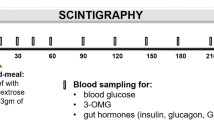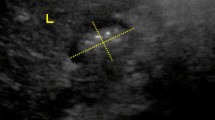Abstract
We simultaneously recorded gastric emptying of radio-opaque markers (ROMs) and monitored serial changes in plasma acetaminophen (AAP) levels to demonstrate the relationship between the ROM and the AAP methods, and we investigated the effect of a single intravenous dose of erythromycin (EM) on gastric emptying in healthy human subjects. After an overnight fast, subjects were randomized to receive either placebo or EM lactobionate (Abbott, North Chicago, IL, USA) 250 mg intravenously in a single dose, given immediately before a standard meal. Subjects ingested 1.5 g of AAP and ROMs with the test meal. A supine plain abdominal radiograph was taken 1, 2, 3, and 6h after ingestion of the test meal. Peripheral blood samples were obtained 0, 0.5, 1, 1,5, 2, 3, and 6 h after ingestion of the test meal. EM significantly accelerated gastric emptying of ROMs. By 6 h, no markers remained in the stomach in any of the subjects in the placebo or EM groups. By 120 min, half of the ROMs had passed into the duodenum in 12.5% of subjects after placebo, whereas EM injection resulted in gastric emptying of half of the ROMs in all subjects. There was no difference in plasma AAP concentration between the placebo and EM groups. There were significant correlations between maximum plasma AAP concentration and gastric emptying of ROMs 120 min after ingestion (r=0.546;P=0.019), and between time of maximum plasma AAP concentration and gastric emptying of ROMs 120 min after ingestion (r=−0.568;P=0.014). The time taken to reach the peak concentrations ranged from 30 to 90 min after ingestion, whereas most ROMs were emptied 120 min after ingestion. We conclude that the gastric emptying assessed by ROMs and by serial changes in plasma AAP level are good, non-invasive, clinically applicable tests, with a significant correlation between the two tests. A single intravenous dose of EM had a prokinetic effect on gastric emptying, assessed by ROMs, in healthy human subjects.
Similar content being viewed by others
References
Moore JG, Christian PE, Coleman RE. Gastric emptying of varying meal weight and composition in man. Evaluation by dual liquid- and solid-phase isotopic method. Dig Dis Sci 1981;26:16–22.
Feldman M, Smith HJ, Simon TR. Gastric emptying of solid radioopaque markers: Studies in healthy subjects and diabetic patients. Gastroenterology 1984;87:895–902.
Chang CS, Chen GH, Kao CH, et al. Gastric clearance of radiopaque markers in non-ulcer dysepsia patients. Scand J Gastroenterol 1996;31:136–139.
Mizuta H, Kawazoe Y, Haga K, et al. Effects of meals on gastric emptying and small intestinal transit times of a suspension in the beagle dog assessed using acetaminophen and salicylazosulfapyridine as markers. Chen Pharm Bull 1990;38:2224–2227.
Heading RC, Nimmo J, Prescott LF, et al. The dependence of paracetamol absorption on the rate of gastric emptying. Br J Pharmacol 1973;47:415–421.
Itoh Z, Nakaya M, Suzuki T, et al. Erythromycin mimics exogenous motilin in gastrointestinal contactile activity in the dog. Am J Physiol 1984;247:G688–694.
Peeters T, Mathijs G, Depoortere I, et al. Erythromycin is a motilin receptor agonist. Am J Physiol 1984;257:G470–474.
Kondo Y, Torri K, Itoh Z, et al. Erythromycin and its derivatives with motilin-like biological activities inhibit the specific binding of125I-motilin in duodenal muscle. Biochem. Biophys Res Commun 1988;150:877–882.
Minocha A, Katragadda R, Rahal PS, et al. Erythromycin shortens orocecal transit time in diabetic male subjects: A double-blind placebo-controlled study. Aliment Pharmacol Ther 1995;9:529–533.
Smith HJ, Feldman M. Influence of food and marker length on gastric emptying of indigestible radiopaque markers in healthy humans. Gastroenterology 1986;91:1452–1455.
Harasawa S, Tani N, Suzuki S, et al. Gastric emptying in normal subjects and patients with peptic ulcer. A study using the acetaminophen method. Gastroenterol Jap 1979;14:1–10.
Hatanaka S, Kondoh M, Kawarabayashi K, et al. The measurement of gastric emptying in conscious rats by monitoring serial changes in serum acetaminophen level. J Pharmacol Toxicol Methods 1994;31:161–165.
Meyer JH, Dressman J, Fink A, et al. Effect of size and density on canine gastric emptying of nondigestible solids. Gastroenterology 1985;89:805–813.
Fiorucci S, Distrutti E, Gerli R, et al. Effect of erythromycin on gastric emptying and gallbladder emptying and gastrointestinal symptoms in scleroderma patients is maintained medium term. Am J Gastroenterol 1994;89:550–555.
Tomomasa T, Karoumi T, Arai H, et al. Erythromycin induces migrating motor complex in human gastrointestinal tract. Dig Dis Sci 1986;31:157–161.
Hasler W, Heldsinger A, Soudah H, et al. Erythromycin promotes colonic transit in humans: Mediation of motilin receptors (abstract). Gastroenterology 1990;98:358.
Fiorucci S, Distrutti E, Bassotti G, et al. Effect of erythromycin administration on upper gastrointestinal motility in scleroderma patients. Scand J Gastroenterol 1994;29:807–813.
Annese V, Janssens J, Vantrappen G, et al. Erythromycin accelerates gastric emptying by inducing antral contractions and improved gastroduodenal coordination. Gastroenterology 1989;96:110–115.
Janssens J, Peeters TL, Vantrappen G, et al. Improvement of gastric emptying in diabetic gastroparesis by erythromycin. N Engl J Med 1990;322:1028–1037.
Tomomasa T, Kuroume T, Arai H, et al. Erythromycin-induced migrating motor complex in human gastrointestinal tract. Dig Dis Sci 1986;31:157–161.
Minami H, McCallum RW. The physiology and pathophysiology of gastric emptying in humans. Gastroenterology 1984;86:1592–1610.
Keshavarzian A, Isaac RM. Erythromycin accelerates gastric emptying of indigestible solid and transpyloric migration of the tip of an enteral feeding tube in fasting and fed states. Am J Gastroenterol 1993;88:193–197.
Author information
Authors and Affiliations
Rights and permissions
About this article
Cite this article
Park, H.J., Jung, J.K., Song, K.S. et al. Effect of erythromycin on gastric emptying in healthy individuals assessed by radio-opaque markers and plasma acetaminophen levels. J Gastroenterol 32, 734–739 (1997). https://doi.org/10.1007/BF02936948
Received:
Accepted:
Issue Date:
DOI: https://doi.org/10.1007/BF02936948




